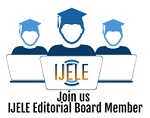(2) * Sularso Sularso
(3) Dash Enkhtungalag
*corresponding author
AbstractIn learning activities, creativity is an important aspect, where students can improve and develop their creative talents and abilities in thinking creatively. In grade III students of Muhammadiyah Al-Mujahidin Elementary School, Wonosari, there are still some students who are less interested in music art subjects. This study aims to determine the effect of theValue Clarification Technique (VCT) learning model on the musical creativity of grade III students, the efforts made by class teachers to improve musical creativity. This study is a descriptive quantitative study using an experimental method. The research design used is Pre-Experimental Design in the form of a One-Group Pretest-Posttest Design design with a sample of 24 students. Data collection techniques use test and non-test techniques, such as observation, interviews, and documentation. Data is processed using instrument validation and instrument reliability. The results of this study can be seen through the results of the hypothesis test with the Paired Sample t-test technique processed using the IBM SPSS for Windows version 30.0 program, the Sig value (2 Tailed) was obtained at 0.000, which means the Sig value <0.05, which means H0 is rejected and H1 is accepted. So it can be concluded that the Value Clarification Technique (VCT) learning model has an effect on the student’s outcome’s ability to play music creativity of grade III students in Muhammadiyah Al-Mujahidin Elementary School, Wonosari.
KeywordsMusical Creativity; Value Clarification Technique (VCT); Learning Model; Music Arts Learning; Educational Experiment
|
DOIhttps://doi.org/10.31763/ijele.v6i3.2082 |
Article metrics10.31763/ijele.v6i3.2082 Abstract views : 0 | PDF views : 0 |
Cite |
Full Text Download Download
|
References
[1] H. Kirschenbaum, “Clarifying Values Clarification: Some Theoretical Issues and a Review of Research,” Gr. Organ. Stud., vol. 1, no. 1, pp. 99–116, Mar. 1976, doi: 10.1177/105960117600100109.
[2] D. Destari, H. Kurniawati, A. Tesalonika Yolanda, H. Tannady, and M. Magdalena, “The Analysis of Improving Student Learning Outcomes Using The Value Clarification Technique Learning Model,” J. Educ., vol. 6, no. 1, pp. 3300–3305, 2023, doi: 10.31004/joe.v6i1.3395.
[3] R. Y. Ula, S. Sarkadi, and A. Badrujaman, “The Effectiveness of Value Clarification Technique Learning Model on Students’ Learning Outcomes,” J. Pendidik. dan Pengajaran, vol. 54, no. 1, p. 38, 2021, doi: 10.23887/jpp.v54i1.29589.
[4] Ultas, U. Dhyana, U. Pendidikan, and G. Singaraja, “Pengembangan Model Pembelajaran Value Clarification Technique (VCT) Berbasis Cerita Rakyat Dalam Pembelajaran PPKn di Sekolah Dasar,” Mataram, Fkip Univ. Ekon. Fak, vol. 9, no. 3, pp. 780–788, 2021.
[5] A. Dewantoro and K. E. Sartono, “The influence of value clarification technique (VCT) learning model on homeland attitude at elementary school,” Sci. Pedagog. Educ., vol. 0, no. 5 (32), pp. 23–31, 2019, doi: 10.15587/2519-4984.2019.177106.
[6] C. J. Maker, “Exceptional talent in the 21st century context: Conceptual framework, definition, assessment, and development,” Gift. Educ. Int., vol. 37, no. 2, pp. 158–198, May 2021, doi: 10.1177/0261429421995188.
[7] E. A. Nurdin and Wahyudin, “The Implementation of Project Based Learning to Improve Student Creativity and Learning Outcomes,” Proc. 7th Math. Sci. Comput. Sci. Educ. Int. Semin. MSCEIS 2019, pp. 1–5, 2020, doi: 10.4108/eai.12-10-2019.2296340.
[8] A. K. Sukandar and I. W. Astika, “Upaya Meningkatkan Kemampuan Bermain Alat Musik Anak dengan Pembelajaran Berbasis Kreativitas ( Improving Children ’ s Musical Ability through Creativity Learning ),” vol. 2, no. 5, pp. 805–814, 2020.
[9] M. A. Cardoso, E. M. G. Morgado, and L. Leonido, “Unleashing Creative Synergies: A Mixed-Method Case Study in Music Education Classrooms,” Appl. Sci., vol. 13, no. 17, 2023, doi: 10.3390/app13179842.
[10] K. Ulger, “The Effect of Problem-Based Learning on the Creative Thinking and Critical Thinking Disposition of Students in Visual Arts Education,” Interdiscip. J. Probl. Learn., vol. 12, no. 1, 2018, doi: 10.7771/1541-5015.1649.
[11] I. Supena, A. Darmuki, and A. Hariyadi, “The influence of 4C (constructive, critical, creativity, collaborative) learning model on students’ learning outcomes,” Int. J. Instr., vol. 14, no. 3, pp. 873–892, 2021, doi: 10.29333/iji.2021.14351a.
[12] W.-C. Ho, “Perceptions of values and influential sources of creativity, music types, and music activities in school music learning: a study of students in Changsha, China,” Music Educ. Res., vol. 24, no. 1, pp. 1–17, Jan. 2022, doi: 10.1080/14613808.2021.2007230.
[13] D. T. K. Ng, E. H. L. Ng, and S. K. W. Chu, “Engaging students in creative music making with musical instrument application in an online flipped classroom,” Educ. Inf. Technol., vol. 27, no. 1, pp. 45–64, Jan. 2022, doi: 10.1007/s10639-021-10568-2.
[14] V. Heap and J. Waters, “Data collection methods,” in Mixed Methods in Criminology, Abingdon, Oxon ; New York, NY : Routledge, 2018.: Routledge, 2019, pp. 141–176. doi: 10.4324/9781315143354-8
[15] S. T. Fife and J. D. Gossner, “Deductive Qualitative Analysis: Evaluating, Expanding, and Refining Theory,” Int. J. Qual. Methods, vol. 23, pp. 1–12, Jan. 2024, doi: 10.1177/16094069241244856.
[16] C. Viswesvaran and D. S. Ones, “Non-Test Methods and Techniques Used in Employee Selection,” in The SAGE Handbook of Industrial, Work and Organizational Psychology: Personnel Psychology and Employee Performance, 1 Oliver’s Yard, 55 City Road London EC1Y 1SP: SAGE Publications Ltd, 2018, pp. 451–472. doi: 10.4135/9781473914940.n16
[17] S.-A. Mirhosseini, “Collecting Data Through Observation,” in Doing Qualitative Research in Language Education, Cham: Springer International Publishing, 2020, pp. 61–84. doi: 10.1007/978-3-030-56492-6_4
[18] Q. Yao, “Concepts and Reasoning: a Conceptual Review and Analysis of Logical Issues in Empirical Social Science Research,” Integr. Psychol. Behav. Sci., vol. 58, no. 2, pp. 502–530, Jun. 2024, doi: 10.1007/s12124-023-09792-x.
[19] I. M. Castillo-Martínez, M. S. Ramírez-Montoya, L. D. Glasserman-Morales, and J. A. Millán-Arellano, “eComplex: validity and reliability of rubric for assessing reasoning for complexity competency,” Qual. Quant., vol. 58, no. 2, pp. 1545–1563, Apr. 2024, doi: 10.1007/s11135-023-01697-6.
[20] R. B. D’Agostino, “Tests for the Normal Distribution,” in Goodness-of-Fit Techniques, Routledge, 2017, pp. 367–420. doi: 10.1201/9780203753064-9
[21] S. Sovey, K. Osman, and M. E. E. Mohd-Matore, “Exploratory and Confirmatory Factor Analysis for Disposition Levels of Computational Thinking Instrument Among Secondary School Students,” Eur. J. Educ. Res., vol. volume-11-, no. volume-11-issue-2-april-2022, pp. 639–652, Apr. 2022, doi: 10.12973/eu-jer.11.2.639.
[22] K. Okoye and S. Hosseini, “T-test Statistics in R: Independent Samples, Paired Sample, and One Sample T-tests,” in R Programming, Singapore: Springer Nature Singapore, 2024, pp. 159–186. doi: 10.1007/978-981-97-3385-9_8
[23] J. Cohen, Statistical Power Analysis for the Behavioral Sciences. Routledge, 2013. doi: 10.4324/9780203771587
[24] B. Kurniawan, S. M. Towaf, Sukamto, A. Purnomo, and Idris, “Outdoor learning based on natural laboratory as social studies learning resources for strengthening student’s insights and characters,” in Community Empowerment through Research, Innovation and Open Access, London: Routledge, 2021, pp. 145–150. doi: 10.1201/9781003189206-27
[25] N. Suryani, “VCT (Value Clarification Technique) learning model application to improve historical value understanding,” Hist. J. Pendidik dan Peneliti Sej., vol. 11, no. 2, p. 198, Aug. 2018, doi: 10.17509/historia.v11i2.12382.
[26] S. Hallam, “Music Learning,” in International Encyclopedia of Education, Elsevier, 2010, pp. 407–412. doi: 10.1016/B978-0-08-044894-7.00520-0
[27] S. Rimkut?-Jankuvien?, “Development of Musical Creativity of Higher Class Pupils Using Musical Computer Technologies (MCT),” Soc. Technol., vol. 3, no. 2, pp. 303–315, 2013, doi: 10.13165/st-13-3-2-05. doi: 10.13165/ST-13-3-2-05
Refbacks
- There are currently no refbacks.
Copyright (c) 2024 Sularso Sularso, Alifah Puspita Gayatri

This work is licensed under a Creative Commons Attribution-ShareAlike 4.0 International License.

International Journal of Education and Learning
ISSNÂ 2684-9240
Published by Association for Scientific Computing Electronics and Engineering (ASCEE)
W : http://pubs2.ascee.org/index.php/ijele
E : zalik@ascee.org

This work is licensed under a Creative Commons Attribution-ShareAlike 4.0 International License.






















